
In recent years, the term “PAWG” has emerged as a notable trend, particularly within the realms of social media, online forums, and certain corners of popular culture. Standing for “Phat A** White Girl,” the term is used to describe Caucasian women who possess an exaggeratedly curvy, particularly well-endowed, posterior. This article will explore the origin of the term, its growing popularity, and the broader cultural conversation it has sparked.
Understanding the Origins of PAWG
The concept of PAWG can be traced back to the early 2000s when the term first began appearing on internet forums and in hip-hop music. The use of “phat,” a slang term from the African American Vernacular English (AAVE), traditionally meant something positive or attractive. The phrase “Phat A** White Girl” soon became a specific descriptor for women who fit this particular body type.
The Influence of Social Media
Social media platforms like Instagram, TikTok, and Twitter have played a significant role in popularizing the trend. Influencers and content creators often use the hashtag to tag images and videos, which are then shared widely among followers. The growing use of this hashtag reflects a broader acceptance and celebration of diverse body types, though it also raises questions about objectification and the pressures placed on women to conform to specific beauty standards.
The Cultural Impact of PAWG
PAWG in Music and Entertainment
The rise of PAW in popular culture cannot be separated from its representation in music, particularly within the hip-hop and rap genres. Numerous songs and music videos have highlighted women with curvaceous figures, contributing to the normalization and celebration of this body type. Artists such as Sir Mix-a-Lot, who famously sang “I like big butts and I cannot lie,” have long played a part in this cultural shift.
Body Positivity vs. Objectification
While some argue that the trend promotes body positivity by celebrating curvy women, others criticize it for perpetuating the objectification of women’s bodies. The term itself is a double-edged sword—on one hand, it acknowledges and appreciates a body type often overlooked by traditional beauty standards; on the other hand, it reduces women to their physical attributes, stripping away their individuality.
Statistics and Popularity Trends
According to Google Trends, searches for “PAWG” have seen a consistent rise over the past decade, particularly in Western countries. The trend is most prevalent in the United States, Canada, and parts of Europe. The increasing popularity of the term can be attributed to its use in adult content as well as its presence in mainstream media.
Read More
Also read about Understanding Sex Tourists: A Global Issue
FAQs About PAWG
- What does this stand for?
- PAWG stands for “Phat A** White Girl,” a term used to describe Caucasian women with a curvaceous figure.
- Where did the term PAWG originate?
- The term originated in the early 2000s, emerging from internet forums and hip-hop culture.
- Is the term PAWG considered offensive?
- The term can be seen as both empowering and objectifying, depending on context and interpretation. Some view it as a celebration of body diversity, while others criticize it for reducing women to their physical attributes.
- Why is PAWG trending on social media?
- The term has gained popularity on platforms like Instagram and TikTok, where it is often used as a hashtag to celebrate curvy body types.
- How does PAWG relate to body positivity?
- PAWG is sometimes associated with the body positivity movement, as it challenges traditional beauty standards by celebrating curvier body types. However, it also raises concerns about the objectification of women.
Conclusion
The term PAWG has undoubtedly left its mark on popular culture, reflecting broader societal trends around beauty, body image, and the power of social media. While it serves as a celebration of a body type that challenges conventional beauty norms, it also highlights the ongoing conversation around the fine line between empowerment and objectification. As with any cultural phenomenon, the implications of PAWG are complex and multifaceted, deserving of critical reflection.











